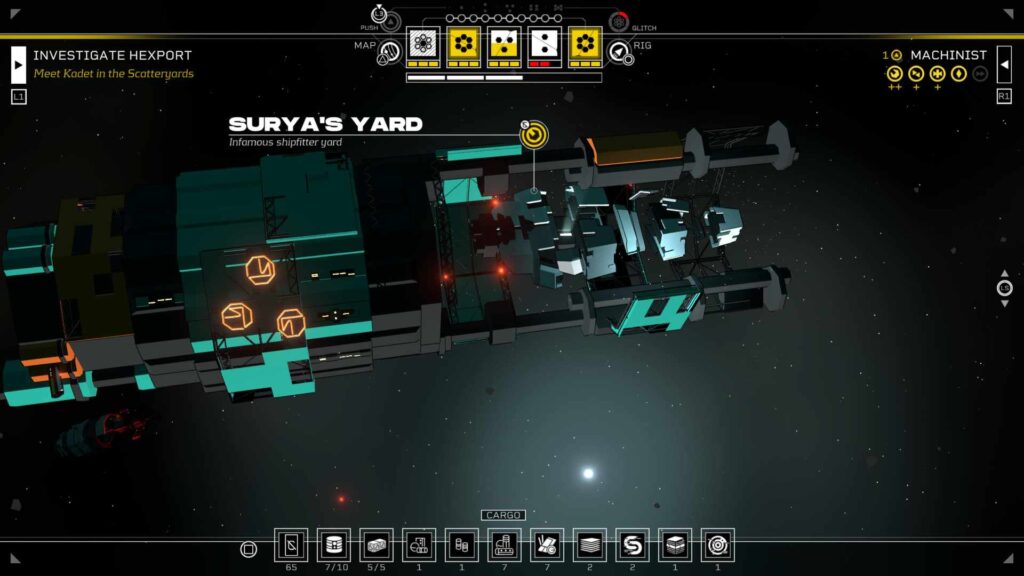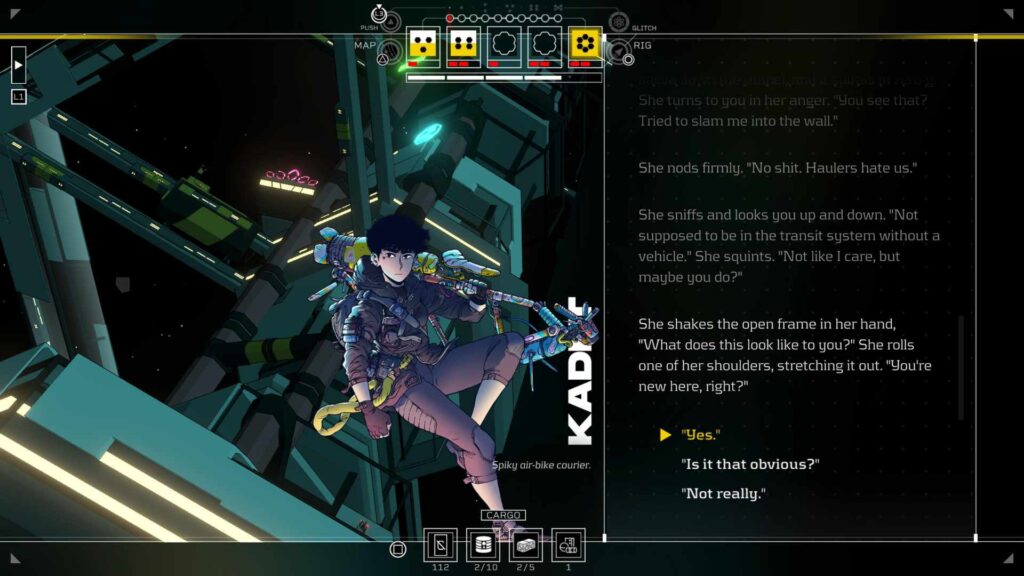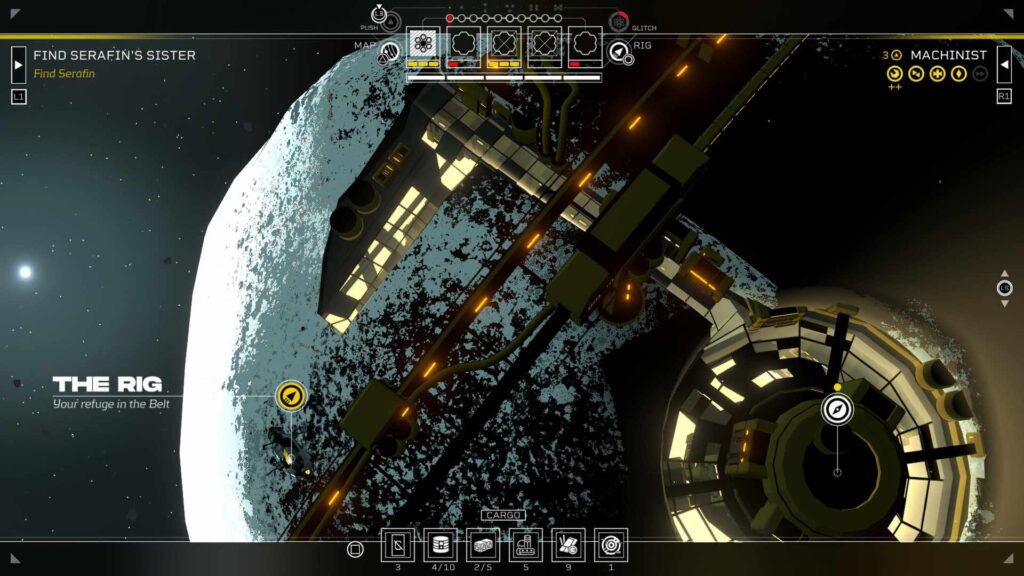One of the benefits of getting to review games is the inherent need to push past any trepidation you have, any daunting mechanics, to reach a point where you feel you can be fair and accurate with the title. I remember enjoying the first Citizen Sleeper, loving the idea of it and wanting to play more and more of it, but unfortunately fizzling out on the fear I might ruin my run at any second. Honestly, any game with choices and chances might see me stop playing for any reason despite how much I’m enjoying it on the sole basis that I am too afraid to mess up everything by not thing
Citizen Sleeper 2, follows suit by keeping the game relatively unchanged. In this I was nervous I might not want to keep playing and going when I landed on a bad decision and I was stuck living with it. There were times I kinda wanted to as well. However, since this was a review I kept moving forward, experiencing the world, taking chances, and making choices, right up until the credits rolled. Quickly though, I found I was making excuses. It stopped feeling like a chore. something to push through, early on. It only felt like that when I was relearning the mechanics. I was having a lot of fun, and enjoying everything the game had to offer.

A Roll of The Dice
Citizen Sleeper 2 is heavily inspired by tabletop games like, with a dice-rolling mechanic at the core of its experience. The player takes the role of a sleeper, a sort of humanoid robot with a simulated human mind. When you start you get the choice between three frames that you will play through the story. While not a deep choice, there is no customization, this decision between frames has a huge impact on your game. The player has access to 5 stats that impact your dice rolls even early on and all frames cut you off from a major statline. This one stat you drop will cause dice used in those situations to lose points, dropping say a dice with a 4 to a dice with a 2. You have positive attributes as well and can gain points, but those require leveling up first. Annoyingly, both of these effects have the same red effect on them which, I mean you will figure it out through visual cues, but doesn’t prevent you from feeling like you are messing up on a guaranteed roll of 6, the highest you can achieve.
Each day you roll a set number of dice that can be used on anything you want to, with the caveat being that once you run out you really can’t do anything. Early on in the game, the player has a time constraint placed on them which forces them to keep moving, making some actions like lingering around in a place to get some extra money a little nervewracking, though soon this limit should be easily manageable. Since you ALWAYS need fuel and supplies to go anywhere, and money really doesn’t come easy early on, balancing these elements makes up the first hurdle players really need to overcome. This early game grinding can be daunting in general. Your dice rolls are often not good, you constantly need money you don’t have, and missions can be challenging because of all this. It gets better, it really does, but this was the grind that made me lose confidence in myself the first time around. It’s the cardinal sin of making the sequel that acts as an extension.
The RNG mechanic of Dice in general remains the most intrinsic flaw of the series. I’m pretty sure (but not confident) that as the player levels up their dice roles gain a higher percentage of being high roles. It may be something else that contributes to this but by the late game, I had far more hands of 5’s and 6’s. This doesn’t stop the game, even then from throwing you a low hand of nothing but 2’s. Missions are impacted most by this, having time constraints through your supplies inherently, but occasionally time constraints the narrative will give you. Dice rolls can lead to one of three outcomes, a positive when only good things occur, a neutral which offers a good and bad outcome, and a bad role which is usually a higher bad. One negative is stress, which when high enough starts hurting your dice until they break. Some missions are very grindy even with full dice, so losing one or two can significantly hurt your ability to complete the mission without accruing even more stress numbers further.
In one mission, we traveled to a planet searching for a vault on a ship. In fairness, I made the mistake of assuming that in the three places you could search, the too-obvious location to search for the ship’s vault was, you know, on the ship. Another crew arrived and the game gave me a three-turn limit to complete the task. This would have been fine but, the next roll was all 1’s and 2’s. I chose to forgo this out of concern for using these and hitting the wrong side of the percentage… The next role was not better. This time I risked it cause I couldn’t be sure a single turn could end up well, this led to only about two neutral rolls and everything adding stress, which led to the next turn where I needed at least three good dice to complete the task and I was now 2 dice down. Needless to say, it didn’t go well. The game compounds a failed task by you not earning anything so, I hurt myself on that mission with no relief to stop the bleeding. Sometimes a bad roll actually contributes to failing a mission by causing grinding problems to occur or contributing to a failure metric that ticks up with every neutral or bad role.
Additionally, these missions and all tasks really can be very grindy. Completion of everything involves a radial with a certain amount of slices that each good roll fills up a certain amount. Discovering areas in colonies, completing objectives in missions, and sometimes just unlocking tasks, all use this element so you will see it a lot. There really isn’t any form of a second mechanic to switch up the gameplay from this. Once you get into a groove and level up a bit this becomes a much more manageable mechanic, but it doesn’t change the fact that some tasks can take 3 or 4 cycles (the games day mechanic) to complete, opening the same task, throwing dice into it, and the repeating the next day.

Escape To Space
Citizen Sleeper 2 is slow from start to finish with a fairly deep narrative. Similar to a tabletop experience every so often your character will interact with locals, allies, or enemies through lengthy expositions describing every effect of the character. There is no action or animation in these scenes so it can feel a little slower, despite the narrative being well written. A compounding fact to this is that narrative points can stack on top of themselves a lot. At one point a timer to a story event ticked down when landing at a colony. I traveled to a colony for a mission of one of my allies, little did I know landing on this colony was related to another mission, as well as a different narrative. This resulted in me landing and then playing out 4 separate cutscenes playing out one after the other, which can be a little draining.
The plot begins when the player escapes from the antagonist of the game Laine who spends much of the game trying to hunt you down and use you to some end. This creates the early mechanic in which you have to stay ahead of him by moving from place to place which lowers the redial till he catches up to you by there. You will spend a lot of the game under threat of it. Main missions help make it less impactful though as you will often have to jump from place to place, with later needing to reach the outer edges of the map taking two or three jumps. However, when things like broken dice and fuel costs start to pile up a bad situation can start to feel worse.
Throughout the experience, you will be able to take in allies that offer additional narrative. The game kinda treats this like a game of legos, fitting an ally’s two cents or contention into a narrative that remains somewhat unchanged. This being said, the game has an old-school Final Fantasy vibe the way characters you take on contracts and missions will offer unique perspectives on a situation, perspectives that you wouldn’t get had you brought another ally with you. This gives the game not only a meaningful narrative but also replayability if you want to experience everything. Occasionally characters even harken back to moments they previously took part in adding more meaning, even if they don’t have a massive payoff at the end.
The benefit of making allies is that they add extra dice rolls to missions when you take them. This being said they are limited to the same RNG rules as everything else so there are often moments they will roll low, and that can happen much more frequently than your sleeper. The game also makes no mention of what stats will impact roles the most, meaning that in several cases the characters I brought because I liked them end up taking a net loss on nearly every role while already being low Due to their skill not matching any required. If they max stress they are removed from participation for the remained of the contract and in the late game, whenever 4’s tend to result in a negative effect more than neutral, this can add up.
Citizen Sleeper 2 does not have a game-over mechanic, though I never did reach the end of that time, which easily could mean that. A timer similar that sets your time on the first planet as limited keeps going regardless of beating the time or not. In its tabletop roots failure for the most part just lends itself to a new narrative as you continue to progress from failure. It’s not the first game to do this, but it’s a little sour to swallow that you lost when you didn’t really have a chance given through no fault of your own it feels like you never had a chance. When the pressures of risking failure get to much, however, you can always lay back and take in some of the game’s lo-fi (is what I’m calling it) music that is sure to put you in a zen space. The soundtrack genuinely made me feel like I was floating through space in all the best ways.
The story is an emotional exploration that feels like Ghost in The Shell meets Akira, with an art style that is Akira-inspired as well in the character design. As a cyborg with a human-simulated mind, it asks questions of how you affect the world and how you relate to the people around you. It explores themes of fear and love as the game takes its time delving into the state of being of your sleeper and the characters they come to rely on. Citizen Sleeper 2 is strongest when it is self-reflective, and it does so often. On a random side note though, characters wink at you way too much, so so very much.

Verdict
Citizen Sleeper 2 is a slow but meaningful journey into the deepest expanses of space and as such, it plays like it. Characters are well written with an engaging story that plays out over 10 to 15 hours, with weighted choices that can mean the difference between success and failure thanks to autosaving which often means you have to live with these outcomes. The opening can be a little daunting and might seem a little nerve-wracking, but if you stick with it you will come out on the other side better for it with an experience that hits hard.
That doesn’t mean that the game isn’t without its issues, the biggest molded into the nature of the beast. Dice rolls are random and can become frustrating when in the middle of an event you find yourself with the worst hand possible and no way to fix it. The game is also has a lot of grinding with the same element of a radial used to represent every aspect of gameplay. It isn’t a bad mechanic mind you, but even one or two elements to help break it up further would have benefited Citizen Sleeper 2 overall.
In fairness, it is a testament to the game overall that despite these elements, the game manages to be so enjoyable. I wanted to reach the next colony, I wanted to clear the next mission, I wanted to reach the credits, and I wanted to see what happens next. Citizen Sleeper 2 is an outstanding experience and enjoying yourself will not be a game of chance, its guaranteed.
Remember to follow us on Twitter and Facebook to keep up to date on everything we have going on!
Review For PlayStation 5, Also available for Xbox Series S/X, Nintendo Switch, Windows PC, and Game Pass
A code was provided by Fellow Traveller for the purposes of this review.
Developer: Jump Over The Age
Publisher: Fellow Traveller
Release Date: January 31st, 2025
As a sleeper, explore the reaches of space staying one step ahead of a deadly syndicate and helping colonists along the way.
PROS:
+Great and Compelling Story
+Enjoyable Soundtrack
+Well crafted world and characters
+Table-top inspired gameplay
+nostalgic
CONS:
-Grinding with no mechanics to break it up
-Random Number Generated Rolls that can heavily impact
-Narrative pile ups
-
Citizen Sleeper 2